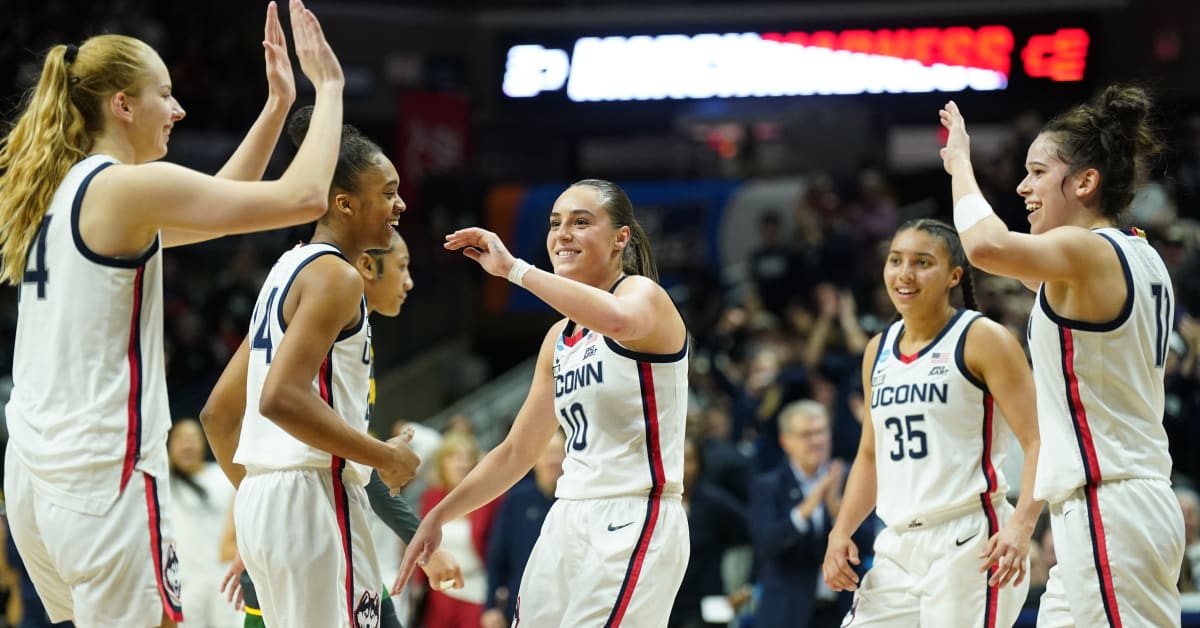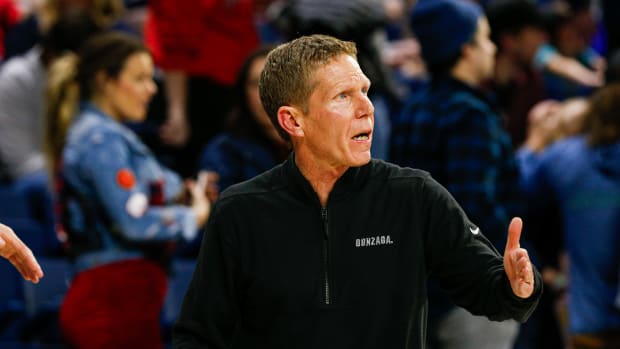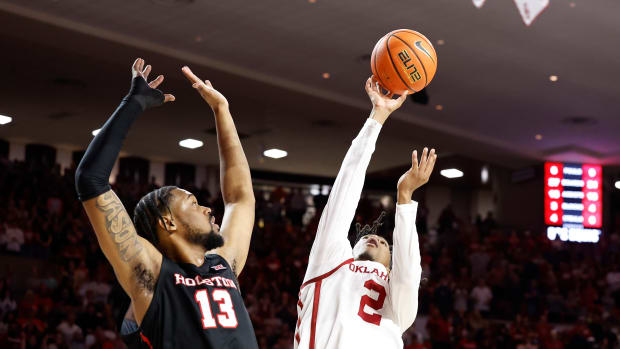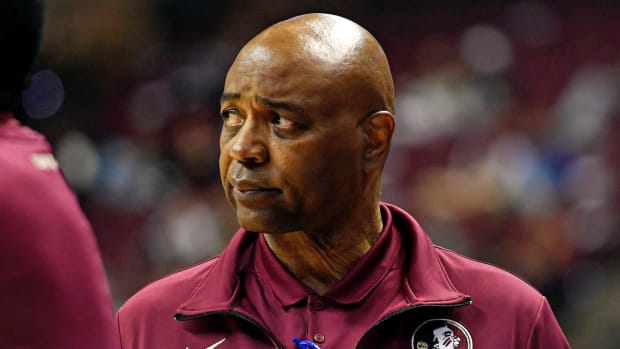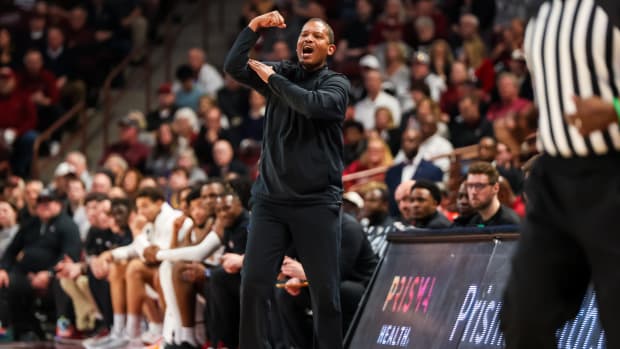Reseeding the Women’s Sweet 16
Welcome to the women’s Sweet 16. After the tournament opened with a whole lot of chalk—including some overwhelming displays of dominance by the top seeds—the following days offered a whole lot of … not. This is the first time in a generation that two No. 1 teams have gone down before the Sweet 16. That naturally means the remaining bracket is a bit more chaotic than you may have expected. So before the first game of the next round tips off Friday at 2:30 p.m. ET—No. 4 Villanova against No. 9 Miami—here’s a revisited ranking of the remaining teams.
1. South Carolina (34–0)
Seed: No. 1 in the Greenville 1 Region
Well, no surprises here: The best team in the country has continued to look every bit the part. There’s simply no one who has been able to compete with the discipline of this masterly defense this year. Their second-round game against South Florida offered a perfect example of that. The Gamecocks came out shooting unusually cold, while the Bulls came out tough, physical and ready to hang. This meant that South Florida led throughout the first quarter and was down by just four points at halftime. But then … it was over. There was no hope of keeping up that performance for long against a team this intense. South Carolina’s physicality soon wore them down and ground them up: The Gamecocks outscored the Bulls 19–7 in the third quarter and 24–9 in the fourth. By the end, it felt unbelievable that South Florida ever had the lead in the first place. And South Carolina’s been doing as much against strong SEC competition all year. In other words? Yeah, a championship repeat looks far more likely than not.
2. UConn (31–5)
Seed: No. 2 in the Seattle 3 Region
The Huskies spent much of the year in a fog of injuries: Most of the season without star guard Azzi Fudd, stretches without Dorka Juhász and Caroline Ducharme, and unfortunately timed illnesses and travel mishaps, too. (Paige Bueckers, of course, was ruled out for the year before the season even started.) Despite all that, UConn finished top five in Division I in field goal percentage, rebound rate and assists per game. The Huskies have now made it to the other side of their nightmare year—and finally, at just the right time, they’re healthy and ready to show what they can do at (almost) full strength.
3. Virginia Tech (29–4)
Seed: No 1 in the Seattle 3 Region
It’s hard to ask for a better two-player combo than Elizabeth Kitley and Georgia Amoore. Kitley is a double-double machine. (She’s recorded 21 of them in the Hokies’ 33 games so far this year.) Amoore is perhaps the best three-point shooter in the country. Together, they lead a team that’s well balanced with plenty of veteran presence.
4. Iowa (28–6)
Seed: No. 2 in the Greenville 1 Region
No team scores more. (The Hawkeyes led Division I with 87.4 points per game.) No team has a higher field goal percentage (51%) or generates more points per play (1.02), or has more assists per game (21.2). And, of course, no other team has Caitlin Clark. But this roster offers more than just the star guard. Clark is joined by Monika Czinano, a dominant presence in the post and an incredibly efficient shooter, and Gabbie Marshall, a three-point weapon. This offense can be the most potent in the country—and that runs deeper than Clark.
5. Maryland (27–6)
Seed: No. 2 in the Greenville 1 Region
If this year once seemed destined to be a transitional period for Maryland—transfer portal turnover left the roster with just one starter from last season—it sure didn’t end up that way. Instead, this high-powered offense has made a name for itself, starting with Diamond Miller, the lone holdover from the starting five last year.
Watch college basketball with fuboTV. Start your free trial today.
6. Utah (27–4)
Seed: No. 2 in the Greenville 2 Region
The Utes’ offense can be overpowering. It’s top five in the country in points per game, field goal percentage and offensive rating, per Her Hoop Stats. That’s led by Alissa Pili (21.0 ppg), Gianna Kneepkens (15.1) and Jenna Johnson (12.1): All three shoot better than 50% from the field. It’s enough to give opposing defenses fits. And to wit—no one forced their opponents to foul more often this season. (Utah’s opponents averaged 21.2 fouls per game compared to 17.6 for the Utes.)
7. LSU (30–2)
Seed: No. 3 in the Greenville 2 Region
There are few players in the tournament as talented as Angel Reese. The sophomore forward averages 23.8 points and 15.7 rebounds per game—she’s a presence who can take over a game on her own and force it to go her way. But she’s just one part of a roster that boasts a strong defense including a rebound rate second only to South Carolina.
8. Tennessee (25–11)
Seed: No. 4 in the Seattle 3 Region
The Lady Vols have looked phenomenal in the tournament so far. Yes, they played double-digit seeds in both rounds, but they still won by an average of a whopping 46 points per game: That kind of dominance is rare in March. It’s also given them a chance to show off their depth, dipping deep into the bench, and keeping everyone relatively fresh for the Sweet 16.
9. Ohio State (27–7)
Seed: No. 3 in the Seattle 3 Region
The Buckeyes spent most of the season without Jacy Sheldon. But it makes a huge difference to have the senior guard on the floor. Now that she’s back at full strength, leading an offense that also boasts three-point threat Taylor Mikesell and Big Ten Freshman of the Year Cotie McMahon? Watch out. And keep your eye on the ball—no team remaining in the tournament has more steals per game.
10. Villanova (30–6)
Seed: No. 4 in the Greenville 2 Region
No one scores like Maddy Siegrist: The 6'2" senior led the nation this year with 29.2 points per game. She’s the anchor of an offense that does an incredible job of protecting the ball—with the best assist-to-turnover ratio in Division I—but it remains to be seen whether the Wildcats have the depth to make a serious tourney run.
11. UCLA (27–9)
Seed: No. 4 in the Greenville 1 Region
The Bruins have made a habit of rising to the occasion for big games this year (even if not always resulting in a win). They hung tough with No. 1 seed South Carolina for three quarters in November, came just two points shy of beating No. 2 seed Utah in January and beat No. 1 seed Stanford in March. Their record is dotted with losses to weaker programs, too. But they’ve shown an ability to play their best when the lights are brightest. And no one has had a tournament performance so far quite like Charisma Osborne, who scored 36 points while shooting more than 50% from the field to ensure UCLA’s second-round win over No. 5 seed Oklahoma.
12. Louisville (25–11)
Seed: No. 5 in the Seattle 4 Region
This was the first time Louisville lost 10 or more games in more than a decade. There were moments this year that looked very, very rough. Over the last few weeks? Not so much. Hailey Van Lith can take over a game seemingly by sheer will. Olivia Cochran has a tremendous ability to battle in the paint. Mykasa Robinson can offer incredible defense. This doesn’t look like the same team it was earlier in the year—and that’s the way they like it. “I'm not saying we have all the answers, because we don't,” Cardinals coach Jeff Walz said after knocking off No. 4 seed Texas. “But we have figured out how to get our kids to play the best when it matters.” It sure looks that way.
13. Ole Miss (25–8)
Seed: No. 8 in the Seattle 4 Region
No one has beaten South Carolina. (In case you somehow forgot.) But there are two programs that were able to take their losses to overtime. One was No. 1 seed Stanford. And the other was Ole Miss … which just knocked out Stanford. This is a tough defense that was battle-tested all year in the SEC, and it’s capable (clearly!) of bringing about some big surprises.
14. Notre Dame (27–5)
Seed: No. 3 in the Greenville 1 Region
With a healthy Olivia Miles and Dara Mabrey, this ranking might be very, very different. Alas. Miles’s season ended with a knee injury in February; Mabrey tore her ACL in January. Even with the best efforts of Sonia Citron and Maddy Westbeld, those absences would be a lot for a team to overcome at any time of year, let alone in March.
15. Colorado (25–8)
Seed: No. 6 in the Seattle 4 Region
The Buffaloes’ defense can be infuriating to play against: They’re capable of grinding down the game to a sloooow pace that flusters and forces bad decisions. That was on full display in their upset of No. 3 seed Duke—a defense-minded team itself. But as for Colorado’s offense? Well, there’s a reason they’re this far down this list.
16. Miami (21–12)
Seed: No. 9 in the Greenville 2 Region
There’s little to recommend Miami against the rest of these teams on paper. (All 15 other programs here rank in the top 25 by simple RPI; Miami barely makes the top 50 at #48.) But there was little to recommend them against No. 1 seed Indiana, either, and you saw how that turned out. That’s just March. Sometimes, Destiny calls, and it’s as simple as that.
